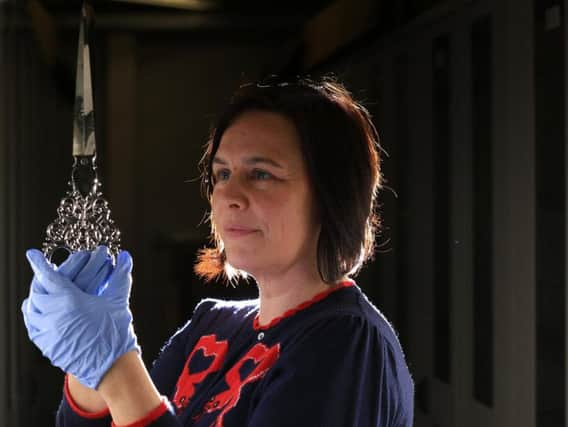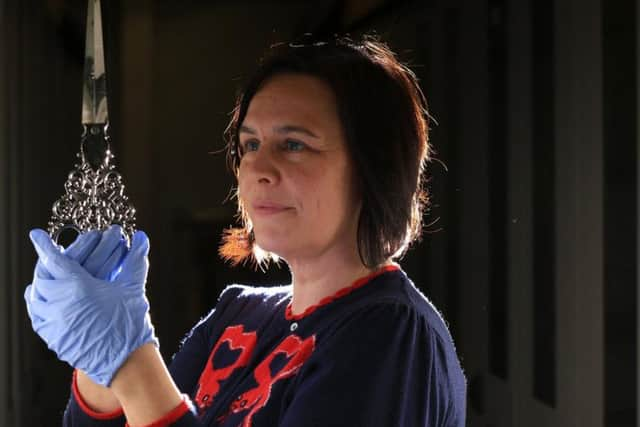A Sheffield collection that is more than mere decoration


"Even if your hands are clean, if you touch high-quality steels it can irrevocably damage them," she says warily, holding up a pair of ornate scissors. "Once it's started, as it were, the rot's set in, there's no undoing it. It eats into the metal."
Look but don't touch is the motto, then - and there's plenty to see. The decorative art collection covers ceramics, glass, arms and armour as well as a huge array of knives, forks and spoons; only to be expected in a city synonymous with cutlery.


Advertisement
Hide AdAdvertisement
Hide Ad"Cutlery, of course, includes anything that can cut. I'm looking at razors at the moment because I'm hoping to do an exhibition in the metalwork gallery about men's grooming in the next year or so. A colleague of mine had an idea, saying 'Everybody's got a beard, let's do something about beards!' It's a hipster thing. She did a lot of research about the Victorian ideas behind facial hair, that the bushier your beard was the more manly you were. It seems to be fashionable again, nothing's ever new."
Last year the council announced its intention to upgrade the Graves Gallery and Central Library in the city centre, turning it into a landmark 'cultural hub’ after the idea of creating a five-star hotel at the building with Chinese investment money failed to gain momentum. In the last of five special features, The Star takes a look at how Museums Sheffield wants to make more of its vast archive as the gallery redevelopment plans take shape.


Clare's collection reaches back to prehistory. A primitive, paleolithic cutting tool is one of the earliest items held, while some of the razors were used by the Romans.
"About half of the collection is not from Sheffield, it's from all over the world," she says, picking up a large Turkish sword acquired in the 1920s. The museums decided early on to gather artefacts from across the globe. "The idea was metalworkers would come and be wonderfully inspired to make a knife or fork."
Advertisement
Hide AdAdvertisement
Hide AdThis ethos continues today through projects with local silversmiths and cutlers like Michael May and Stuart Mitchell, both based at Portland Works. Students at Sheffield Hallam University are involved too, and recent commissions were backed by the city's Assay Office, in a bid to encourage people to train here.
One maker, Sarah Pasley, created a cup with Sex Pistols and Public Image Ltd frontman John Lydon in mind. "He's a big tea drinker, but he only drinks out of nice cups and saucers. With buttered crumpets," says Clare, referencing the punk singer's TV ads for Country Life spread. The cup, incidentally, is displayed upside down. "Because of the idea he turned the music industry upside down."
Meanwhile Florence Maisie Carter toured seven buildings and made etchings of the different textures she found. "A lot of makers are keen on the unique geography of Sheffield."
Last year, an exhibition at Weston Park Museum offered the largest display of Sheffield's Grice Ivories in more than 15 years. The pieces are extraordinary but controversial, Clare agrees. "They're such a wonderful collection and people are really interested in discussing the ideas behind them. We'd like to have that debate, as we did when they were exhibited in 2017."
Advertisement
Hide AdAdvertisement
Hide AdThe ceramics are 'a little bit random' - the Rockingham and Midhope potteries, both South Yorkshire names, are represented - and a hoard of medical instruments inspires grim fascination.
"We've got all sorts of unpleasant and disgusting things," says Clare, opening a drawer and examining a wince-inducing bone clamp.
A good proportion of the cutlery kept in storage is fairly plain in appearance - a deliberate policy, it turns out. "The temptation is to only collect the fancy stuff, and that's wrong. You need everything, to tell the story of people's everyday lives."
Donations of Victorian and Edwardian electroplated tableware - "middle-class things" - are being documented presently. "If somebody was getting married or setting up house they'd flick through a catalogue and say 'I'll have some asparagus tongs and strawberry servers'. Things you never knew you needed."
Advertisement
Hide AdAdvertisement
Hide AdThe acquisition of stainless steel, a line Sheffield has cornered the market in, began five years ago. "No-one else has got anything to borrow things. We've got a really good collection and can be very proactive in filling in gaps."
The city's decorative art collection is in a class of its own more generally, Clare argues.
"The fact it covers all the different countries, time periods and manufacturers is what makes it unique. We have very specific groups of people come here. We've had the Silver Spoon Society, and the Wine Label Society - who knew it was a thing?"
